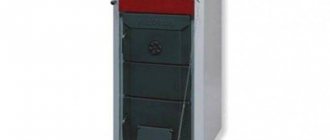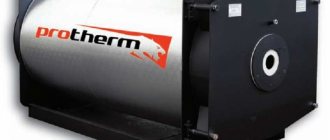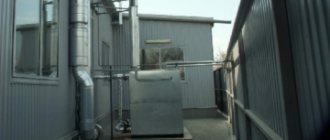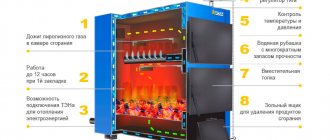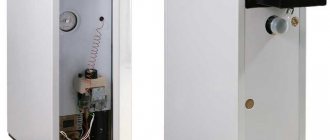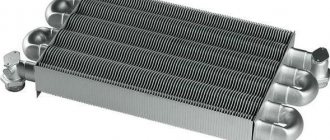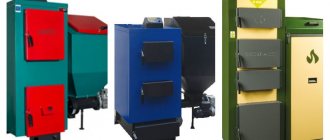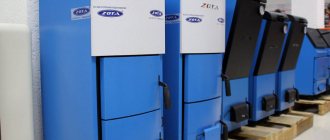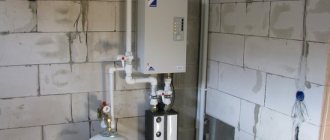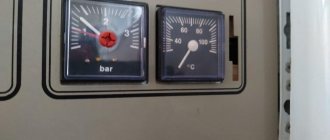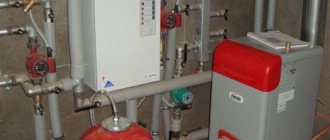Home / Electric boilers
Back
Published: March 24, 2020
Reading time: 5 min
0
1203
The ion boiler is used as a heating source in facilities where it is most efficient to use electricity.
Such devices have minimal weight and compact dimensions, making their installation simple and reliable. For installation, it is not necessary to obtain permits from regulatory authorities. In the case when it is necessary to heat a large area, not one ion boiler is installed, but several devices.
This scheme allows you not only to heat the house, but also to heat water for domestic use through an external hot water storage tank.
- 1 History of the appearance of ion boilers
- 2 Advantages and disadvantages
- 3 Design and technical characteristics
- 4 How to choose an ion boiler
- 5 Best manufacturers
- 6 Diagram of the heating system for an ion boiler 6.1 General diagram of connecting an ion boiler
- 6.2 Do such boilers need to be grounded?
What is an electrode boiler
The principle of operation of the unit is clearly demonstrated by the well-known boiler made of two blades and four matches. When such a device is connected to the electrical network, heating 1 liter of water to 100 C occurs within a few minutes.
This heating intensity of the electrode boiler is achieved due to the phenomenon of electrolysis. The essence of the process is that between two electrodes immersed in a liquid electrolyte solution, when an external voltage source is connected, the directed movement of charged particles begins. Ions with a positive charge move to the cathode, and particles with a negative charge are attracted to the anode.
If alternating voltage from a household power supply with a frequency of 50 Hz is applied to the electrodes, within one second the polarity changes 50 times, which entails a periodic change in the direction of movement of the ions. Due to the increased resistance of the aqueous environment and internal friction, kinetic energy is converted into thermal energy, which causes intense heating of the electrolyte solution.
Since water in centralized supply systems has little in common with pure water (H2O) and is a solution of salts of potassium, calcium, magnesium and other elements, it can well be considered an electrolyte. Direct heating of the electrolyte (without contact with the surface of the heating element or body) is called primary.
The fundamental difference between electrode boilers and other electrical installations is that the coolant is heated without contact with the heating element.
It should also be noted that the performance of the unit is directly related to the chemical composition of the coolant.
Advantages of coolant
The XNT-E-35 brand product, in comparison with similar products from other manufacturers, has the following advantages:
- Reliably protects heating equipment from the negative effects of corrosion and mineral deposits. Operating efficiency is maintained for at least 15 years. Due to the absence of oxidation, the heating system becomes more reliable; it does not require complex maintenance and disassembly to remove deposits.
- Environmentally friendly. To prepare the coolant, propylene glycol is used as the main active substance. This compound is absolutely safe for the body and is used as a food additive (index in the international classification E-1520). It is recommended to use this product instead of toxic ethylene glycol based liquids, which are extremely dangerous to the body and should only be poured into completely sealed systems with secure connections and a closed expansion boiler.
- Fire resistance. According to the classification of substances according to the degree of danger adopted in the Russian Federation (established by GOST 12.1.007-76), the coolant is classified as a low-hazard substance. It does not ignite or explode upon contact with open flame and high temperature. It can be used in residential buildings and industrial facilities.
Please note that this mixture comes ready to use. There is no need to dilute the product with water to avoid reducing the concentration of active components and reducing effectiveness.
Manufacturers and average cost
Many heating equipment manufacturers have their own lines of ion-type boilers. Among the most common brands on the market are the following brands:
- "EOU" (Ukraine)
- LLC "Stafor EKO" (Latvia)
- CJSC (Russia)
Small ion boilers (2-3 kW) cost about 3000-3500 thousand rubles. The higher the performance of the equipment, the higher its price. In addition to heating equipment, additional automation is required. It is purchased separately and will cost about 5-6.5 thousand rubles.
Before purchasing, pay due attention to the warranty period. Most manufacturers set it at 2-3 years
By observing operational requirements and regularly (every 3-4 years) replacing the electrodes, the service life can be extended to 10-12 years.
Let's sum it up
Having analyzed all the pros and cons of ion heating equipment, we can draw a conclusion about its profitability. In some aspects it wins, in others it can lose significantly.
However, before choosing heating systems operating on electrical equipment, it is worth considering a number of features:
- If radiators are divided into groups by floor, it is recommended to install an ion boiler on each of them
- It is recommended to wrap the pipes forming the contour with insulation
- You can use antifreeze as a coolant, taking into account its high fluidity
Ion boilers are not suitable for warm baseboard or heated floor systems. They are not capable of reaching a constant operating temperature of 30-45 degrees.
Views: 254
Electric boilers Tenko: classification, technical characteristics, reviews, buy: https://ukrklimat.com.ua/shop/category/otoplenie/kotly/kotly-elektricheskie
Winter is a wonderful time of year. Snow, New Year, waiting for a miracle. What could be better? But after a walk in the cold, you want to come quickly to a warm house and take a hot bath. But not everyone has such an opportunity. Heating is not always strong enough to heat the entire apartment or house, hot water may be turned off, and some simply do not have gas heating. Have you been looking for a solution? On the TENKO website you will find a way out of this situation!
TENKO electric boilers will keep you warm in any bad weather! And not only will the warmth remain in your soul, but also in your fortress - your home!
What is the advantage of TENKO electric boilers compared to manufacturers of other brands, you ask? The first is reliability. To create our products, only the best high quality components are used. The second advantage is durability. TENKO electric boilers operate on the basis of a heating element, which is made of heat-resistant stainless steel, so the boiler will serve you for a long time without annoying problems. Our boilers have two-level protection, which is implemented using a thermostat and a thermal cut-off, which makes the product safer. TENKO electric boilers are the ideal choice of quality and low price. Another undoubted advantage of our boilers is quiet operation.
Our selection of electric boilers will pleasantly surprise you. A variety of products at prices convenient for you - this is exactly what you will find at TENKO! To make the right choice of electric boiler, familiarize yourself with the main characteristics of each type. In total, we provide four main configurations - “Mini”, “Economy”, as well as “Standard” and “Premium”.
Do you find the video useful?
Write
THANK YOU
!
Alexander Barkov
#Electric_boilers #Tenko - excellent household wall-mounted heating equipment, we recommend https://termopara.net.ua/shop/otopitel-nye-kotly/elektricheskie-kotly/elektricheskie-nastennye-kotly/filter/proizvoditel=tenko/
Ion boiler
Many people associate electric heating of a home with the installation of appropriate water boilers with heating elements, convectors, or laying heated film floors. However, there are many more options. In modern private homes, electrode or ion boilers are installed, in which a pair of primitive electrodes transfer energy to the coolant without any intermediaries.
Ion-type heating boilers were first developed and implemented in the Soviet Union to heat submarine compartments. The installations did not cause additional noise, had compact dimensions, there was no need to design exhaust systems, and they effectively heated sea water, which was used as the main coolant.
The heat carrier, which circulates through the pipes and enters the working tank of the boiler, comes into direct contact with the electric current. Ions charged with different signs begin to move chaotically and collide. Thanks to the resistance formed, the coolant heats up.
History of appearance and principle of operation
Within just 1 second, each of the electrodes collides with the others up to 50 times, changing its sign. Thanks to the action of alternating current, the liquid does not divide into oxygen and hydrogen, maintaining its structure. An increase in temperature entails an increase in pressure, which forces the coolant to circulate.
To achieve maximum efficiency of the electrode boiler, you will have to constantly monitor the ohmic resistance of the liquid. At classic room temperature (20-25 degrees), it should not exceed 3 thousand Ohms.
Do not pour distilled water into the heating system. It does not contain any salts in the form of impurities, which means you should not expect it to be heated in this way - there will be no environment between the electrodes to form an electrical circuit.
Read additional instructions on how to make your own electrode boiler here
Characteristics: advantages and disadvantages
An ion-type electrode boiler is characterized not only by all the advantages of electric heating equipment, but also by its own characteristics. The extensive list includes the most significant:
- The efficiency of installations tends to the absolute maximum – not less than 95%
- No pollutants or ion radiation harmful to humans are released into the environment
- High power in a housing that is relatively small in size compared to other boilers
- It is possible to install several units at once to increase productivity, or separate installation of an ion-type boiler as an additional or backup heat source
- Low inertia makes it possible to quickly respond to changes in ambient temperature and fully automate the heating process through programmable automation
- There is no need to install a chimney pipe
- The equipment is not harmed by an insufficient amount of coolant inside the working tank
- Voltage surges do not affect heating performance and stability
You can find out how to choose an electric boiler for heating here
Of course, ion boilers have numerous and very significant advantages. If you do not take into account the negative aspects that arise more often during the operation of the equipment, all benefits are lost.
Among the negative aspects it is worth noting:
- To operate ion heating equipment, you cannot use DC power sources, which will cause electrolysis of the liquid
- It is necessary to constantly monitor the electrical conductivity of the liquid and take measures to regulate it
- It is necessary to ensure reliable grounding. If it breaks down, the risk of being shocked increases significantly
- It is prohibited to use heated water in a single-circuit system for other needs.
- It is very difficult to organize efficient heating with natural circulation; installation of a pump is mandatory
- The temperature of the liquid should not exceed 75 degrees, otherwise the consumption of electrical energy will increase sharply
- Electrodes wear out quickly and need to be replaced every 2-4 years
- Repair and commissioning work cannot be carried out without the involvement of an experienced technician.
Read about other methods of electric heating at home here
Device and technical characteristics
The design of the ion boiler, at first glance, is complex, but it is simple and not forced. Externally, it is a seamless steel pipe, which is covered with a polyamide electrical insulating layer. Manufacturers have tried to protect people as much as possible from electric shock and leaks of expensive energy.
In addition to the tubular body, the electrode boiler contains:
- The working electrode, which is made of special alloys and is held in place by protected polyamide nuts (in models operating from a 3-phase network, three electrodes are provided at once)
- Coolant inlet and outlet pipes
- Ground terminals
- Terminals supplying power to the chassis
- Rubber insulating pads
The shape of the outer body of ion heating boilers is cylindrical. Most common household models meet the following characteristics:
- Length – up to 60 cm
- Diameter – up to 32 cm
- Weight - about 10-12 kg
- Equipment power – from 2 to 50 kW
For domestic needs, compact single-phase models with a power of no more than 6 kW are used. There are enough of them to fully provide heat to a cottage with an area of 80-150 sq. m. For large industrial areas, 3-phase equipment is used. A 50 kW installation is capable of heating a room up to 1600 sq. m.
However, the electrode boiler works most efficiently in conjunction with control automation, which includes the following elements:
- Starter block
- Surge protection
- Controller
Additionally, GSM control modules can be installed for remote activation or deactivation. Low inertia allows you to quickly respond to temperature fluctuations in the environment.
Due attention should be paid to the quality and temperature of the coolant. The optimal liquid in a heating system with an ion boiler is considered to be heated to 75 degrees. In this case, power consumption will correspond to that specified in the documents. Otherwise, two situations are possible:
- Temperature below 75 degrees - electricity consumption decreases along with the efficiency of the installation
- Temperature above 75 degrees - electricity consumption will increase, however, the already high efficiency indicators will remain at the same level
Video guide
Simple DIY ion boiler
Having become familiar with the features and principle by which ion heating boilers operate, it is time to ask the question: how to assemble such equipment with your own hands? First you need to prepare the tools and materials:
- Steel pipe with a diameter of 5-10 cm
- Ground and neutral terminals
- Electrodes
- Wires
- Metal tee and coupling
- Persistence and desire
Before you start putting everything together, there are three very important safety rules to remember:
- Only the phase is supplied to the electrode
- Only the neutral wire is supplied to the housing
- Reliable grounding must be provided
To assemble an ion electrode boiler, just follow the following instructions:
- First, a pipe 25-30 cm long is prepared, which will act as a body
- Surfaces must be smooth and free of corrosion, nicks at the ends must be cleaned
- On the one hand, electrodes are installed using a tee
- A tee is also necessary to organize the outlet and inlet of the coolant
- On the second side they make a connection to the heating main
- Install an insulating gasket between the electrode and the tee (heat-resistant plastic is suitable)
- To achieve a tight seal, the threaded connections must be precisely adjusted to each other.
- To secure the zero terminal and grounding, 1-2 bolts are welded to the body
Having put everything together, you can embed the boiler into the heating system. Such homemade equipment is unlikely to be able to heat a private home, but for small utility areas or a garage it will be an ideal solution. You can cover the installation with a decorative casing, while trying not to restrict free access to it.
Features of installation of ion boilers
A prerequisite for installing ion heating boilers is the presence of a safety valve, pressure gauge and automatic air vent. The equipment must be placed in a vertical position (horizontal or at an angle are not allowed). At the same time, about 1.5 m of supply pipes are not galvanized steel.
The zero terminal is usually located at the bottom of the boiler. A grounding wire with a resistance of up to 4 ohms and a cross-section of over 4 mm is connected to it. You should not rely solely on RAM - it cannot help with current leakage. The resistance must also comply with the rules of the PUE.
If the heating system is completely new, there is no need to prepare the pipes - they must be clean inside. When the boiler crashes into an already operating main, it is necessary to flush it with inhibitors. The markets offer a wide range of products for removing deposits, salts and scale. However, each manufacturer of electrode boilers indicates those that it considers best for its equipment. Their opinion should be followed. By neglecting flushing, it will not be possible to establish the exact ohmic resistance.
It is very important to select heating radiators for the ion boiler. Models with a large internal volume are not suitable, since 1 kW of power will require more than 10 liters of coolant. The boiler will constantly work, wasting some of the electricity in vain. The ideal ratio of boiler power to the total volume of the heating system is 8 liters per 1 kW.
If we talk about materials, it is better to install modern aluminum and bimetallic radiators with minimal inertia. When choosing aluminum models, preference is given to primary type material (not remelted). Compared to the secondary one, it contains fewer impurities, reducing the ohmic resistance.
Cast iron radiators are the least compatible with an ion boiler, since they are the most susceptible to contamination. If it is not possible to replace them, experts recommend observing several important conditions:
- The documents must indicate compliance with the European standard
- Installation of coarse filters and sludge traps is required
- Once again, the total volume of coolant is produced and equipment suitable in terms of power is selected
Manufacturers and average cost
Many heating equipment manufacturers have their own lines of ion-type boilers. Among the most common brands on the market are the following brands:
- "EOU" (Ukraine)
- LLC "Stafor EKO" (Latvia)
- CJSC (Russia)
Small ion boilers (2-3 kW) cost about 3000-3500 thousand rubles . The higher the performance of the equipment, the higher its price. In addition to heating equipment, additional automation is required. It is purchased separately and will cost about 5-6.5 thousand rubles.
Before purchasing, pay due attention to the warranty period. Most manufacturers set it at 2-3 years. By observing operational requirements and regularly (every 3-4 years) replacing the electrodes, the service life can be extended to 10-12 years.
Let's sum it up
Having analyzed all the pros and cons of ion heating equipment, we can draw a conclusion about its profitability. In some aspects it wins, in others it can lose significantly.
However, before choosing heating systems operating on electrical equipment, it is worth considering a number of features:
- If radiators are divided into groups by floor, it is recommended to install an ion boiler on each of them
- It is recommended to wrap the pipes forming the contour with insulation
- You can use antifreeze as a coolant, taking into account its high fluidity
Ion boilers are not suitable for warm baseboard or heated floor systems. They are not capable of reaching a constant operating temperature of 30-45 degrees.
Advantages and disadvantages
The advantages and disadvantages of ion (electrode) heating boilers have already been mentioned earlier, but we will consider this issue more carefully.
Benefits – what are they?
Different sources provide different (sometimes even fabulous) information regarding technical characteristics. But not all of it is true. Or rather, there are small reservations.
- High efficiency (coefficient of performance). Many manufacturers, tearing off their shirts, claim that this coefficient in their products is 100%. Sometimes you can even hear that there are even more than a hundred. In fact, the percentage is very large, no one argues with that. But not 100 percent! After all, no one has canceled the law of conservation of energy.
- Electrode boilers are rightfully considered the lightest among all their “friends”. Behind everyone in this race of scales are induction heaters.
- There is no need to install chimney systems.
- Rapid heating of liquid.
- Eliminating the possibility of system overheating or failure.
- Even power outages will not in any way affect the performance of the boiler. Due to lack of voltage, only a partial loss of power is possible.
- They are environmentally friendly to human health, like, in principle, any other electrical device.
- Cost is the main advantage of ion boilers, given the current rise in prices. If we compare this type of boiler with others, then, of course, the cost remains the lowest. But there is one marketing ploy that needs to be taken into account when choosing and purchasing. We are talking about control units that need to be purchased separately when purchasing ion boilers. In the case of analogues, all blocks and sensors are already installed.
Now about the disadvantages
Despite such tempting advantages of using ion heating boilers, there are a large number of disadvantages, looking at which there is no desire to get involved with this technology. But the reader must decide for himself, since many shortcomings are just someone’s invention and do not deserve special attention.
- The joint operation of electrode boilers is not possible with all heating radiators. The thing is that the recommended material for radiators is aluminum (high quality). When using radiators made of low-quality material containing impurities, the electrical conductivity of the system will decrease.
- Installation of electrode boilers has its own characteristics. First of all, this is due to high grounding requirements. The fact is that their metal cases are involved in the work process. Therefore, the issue of grounding plays an important role in safety.
- There is a temperature limit. It is unacceptable to increase the maximum temperature above 75 degrees. If this regime is not observed, energy overconsumption begins, which affects the quality of heating. The heating limit is monitored automatically.
- Throughout the entire operational period of ion boilers, frequent replacement of electrodes is necessary, which become overgrown quite quickly. But these are just trifles, since all mechanisms require regular diagnostics and periodic replacement of wearable parts.
- This type of boiler cannot be used in an open heating system. Of course, it can be used, but it is highly undesirable. Otherwise, an ideal condition will be created for the formation of corrosion, which will eventually lead to breakdown of the unit.
- Water heated by the boiler must not be used for domestic needs. But this problem can be eliminated; you just need to install an indirect heating boiler for the liquid.
Installation and operation of electrode water heaters
Although installing a heating system with an ion boiler is quite simple, you must first learn a few mandatory rules, without which the system either will not work at all or will become unsafe and short-lived.
Mandatory requirements:
- equip the system with a pressure gauge that will help monitor the pressure in the boiler and pipes;
- be sure to install a safety valve so that the latter releases excess steam;
- it is worth installing automatic air vents;
- take care of the installation of shut-off valves, which must be located after the expansion tank.
The layout of a heating system using an electrode boiler is quite simple. The main thing is to install all its required elements. Namely: air vent and check valves, pressure gauge, drain and safety valves.
The boiler itself must be mounted strictly vertically, since water, when heated, turns into steam and tends upward. Cold liquid is supplied from below. The device must have a separate mount and not hang on pipes. Also, do not install plastic pipes directly at the outlet of the boiler. The first 1.5 meters of the pipe must be metal. The rest of the heating system can be made of metal-plastic pipes.
Before starting the heating system with an ion boiler, it must be completely rinsed with special products. This way you will significantly increase the efficiency and durability of the entire system.
Another important issue is grounding. It must be made of wire with a diameter of 4 mm and having a resistance of no more than 4 ohms. The grounding must be connected to the zero terminal located at the bottom of the water heater.
Particular attention should be paid to the volume of the heating system. Follow a simple rule: for 1 kW of boiler power, the largest displacement is 8 liters
It is easy to calculate that for a power of, for example, 5 kW, the maximum permissible displacement will be 40 liters.
Volume calculation is an important component. If the calculation is incorrect, the efficiency of the device will decrease. The boiler will work harder, which means increased energy consumption and heater wear.
Aluminum radiators are the best choice for private houses with an electrode heating boiler.
Conventional cast iron radiators are not suitable for electrode devices, since they contain a larger amount of impurities that affect the electrical conductivity of the liquid. Here, aluminum or bimetallic batteries are the best choice. It is better to choose those that have the smallest volume to reduce energy costs.
Operating principle of an electrode boiler
As can be seen in the figure, when the polarity of the current changes, the direction of movement of salt ions in water also changes. In this case, the electrode and the device body are used as contacts.
The operating principle of such a device is based on the electrolysis process, that is, the role of the heating element is played by water itself. However, there is one condition: for water to begin to conduct current through itself, the presence of salts is necessary. The more impurities in a liquid, the better it will conduct current. Charged particles of impurities or ions under the influence of electricity begin to move from contact to contact (electrodes). Since the current in a conventional electrical network is variable and its frequency is 50 Hz, the ions change their direction from electrode to electrode 50 times per second.
The home network has a constant voltage of 220 V, hence, based on Ohm's law, as the resistance decreases, the current increases. But water is still not a good conductor, unlike metals such as aluminum or copper, so as the current increases, it begins to heat up. Thanks to this, the efficiency of electrode boilers is close to 100%.
IMPORTANT! The power of the water heater directly depends on the amount of impurities in the water. The more salts, the more powerful the boiler. This simple diagram clearly shows the simplicity of the electrode boiler design
This simple diagram clearly shows the simplicity of the electrode boiler design.
As a rule, a standard boiler is cylindrical in shape. An electrode, also cylindrical in shape, is installed inside the latter. In this case, the first contact in the device is the electrode, and the second is the housing itself. Based on this, there is a need to ground the water heater, since current can flow through its body.
If you decide to buy an electrode heating boiler, the problem of grounding disappears. Most factory models have a body coated with polyamide. The latter plays the role of an insulator
Also pay attention to the size of the water heater. Usually this is a small cylinder with a height of up to 600 mm and a diameter of up to 300-400 mm
Such boilers can develop a power of up to 6 kW, which is quite enough to power the average house or apartment.
Electrode heating boilers and the Russian market
Despite their shortcomings, ion heating boilers still remain in demand in Russian markets. And this is not strange, since this way you can save a lot on heating. Today, both foreign and domestic companies are engaged in their production (which is very pleasing). In order for you to get an idea of a particular brand, a short overview of the most common manufacturing companies will be provided.
Electrode heating boilers can be of different shapes
Ion boilers "Galan"
Galan is a Moscow company that began its work back in the 90s, gradually gaining leading positions both in Russia and in other countries. The main elements of production are three main models:
- "Galan-Ochag";
- "Galan-Geyser";
- "Galan-Vulcan".
“Galan-Ochag” is their smallest creation (weight does not exceed 500 grams). But such miniature size does not at all affect the performance. For example, one such boiler can easily heat a room of 200 square meters. m. Their average cost varies between 4,000 rubles.
Galan-Geyser boilers are mainly used for heating residential premises. Their rated power of 15 kW is enough to heat a room of 450 square meters. m. Naturally, their cost will be slightly higher compared to the previous model. This is about 7,000 rubles.
Now let's talk about the most powerful model - "Galan-Vulcan". Their power (depending on modification) can reach 50 kW. Such boilers are already used for heating large premises (warehouses, supermarkets, etc.). High power and should not be cheap, as in our case - from 10,000 rubles.
Electrode heating boilers "Beryl"
An exclusively Russian creation is “Beryl”, produced in two variations (depending on the power and power supply). Those people who encounter the products of this company for the first time will not be able to help but notice one characteristic feature - the location of the power supply. In this case, it is located right at the top. This difference makes installation and maintenance much easier.
The cost of single-phase boilers (220 V) with the ability to heat rooms up to 150 sq. m. - from 120 to 140 euros.
The cost of three-phase boilers (380 V) with the ability to heat a room up to 400 sq. m. - from 280 to 380 euros.
So, having understood the design, operating principle and advantages, all that remains is to make a decision in favor of one manufacturer or another.
Principle of operation
The operating principle of the ion boiler is based on a school physics course. The water circulating in the system, which is the coolant, passes between the cathode and the anode and undergoes ionization and sets “+” and “-” charged ions in motion. This process is accompanied by the production of thermal energy.
In one second, the polarity of ions changes up to 50 times. The constant change of polarity prevents the decomposition of the coolant into individual elements - chemical elements - O and H2. The increasing temperature in the boiler, in turn, increases the pressure, which ensures continuous circulation of water through the heating circuit.
It should be taken into account that the use of distilled water in such a boiler is impossible. A system designed for sea water will not be able to provide an electrical circuit between the coolant and the electrodes, and therefore the boiler must be filled with a liquid specially designed for this purpose. Preventing the formation of salt deposits, it will protect pipes from corrosion.
Advantages and disadvantages of electrode heating boilers
We will compare electrode models only with other electric water heaters
Gas boilers will not be taken into account, which, of course, are much cheaper to operate, but require obtaining permits for their use, the availability of a project, gas and other special conditions
So, ion boilers can stand out among their analogues in the following ways:
Electrode boilers are the smallest heating elements. Which does not affect their performance at all.
- they are compact, have a simple design, so they are well suited for use in dachas or private homes;
- the devices are not afraid of voltage surges, since the latter only affects the power of the boiler, but not its operation;
- ion water heaters quickly heat up and cool down, so it is convenient to use any automated room temperature control systems with them;
- they are safe, since even in the absence of water the device will not deteriorate, will not cause a fire or short circuit, it simply will not work (there will be no closed circuit);
- they have excellent efficiency, reaching 98%.
Disadvantages of electrode water heaters:
- knowledge in electrical engineering is needed not only to build a boiler, but also to calculate the parameters of the liquid, its electrical conductivity and the amount of impurities;
- Ordinary water, for example, from any heating system, is not suitable for operating the device, since such a liquid contains many free ions;
- air should not be allowed to enter the boiler, as this will accelerate the process of metal corrosion, thereby reducing the service life of the water heater;
- you need to monitor the temperature of the water in the boiler, since if it exceeds 75 degrees, this will significantly increase energy costs;
- when installing the device, it must be grounded, especially for homemade devices;
- The power of the water heater directly depends on the coolant; high-quality and correctly made liquid can increase the power of the device and vice versa;
- they operate on AC power only.
You can use your electrode boiler as an instantaneous water heater by simply connecting it to the water supply system.
In addition, it is worth mentioning several features of the ion water heater:
- it can be used as a regular instantaneous water heater, and not just as a boiler;
- ease of assembly and installation, ease of repair have a positive effect on its popularity;
- very cheap, even if you buy a factory version rather than making it yourself;
- silent, has no impact on the environment or humans, does not emit toxins or harmful substances, so it can be installed anywhere.
No matter how good an ion boiler is, it is still not a worthy replacement for gas analogues. If it is possible to install gas equipment, of course, choose the latter.
Leading electrode heating boilers
Next, we will look at domestic technologies of heating systems that demonstrate effective operating results, coping not only with voltage drops, but also with unstable current in the room. It should be noted that domestic technologies stand out in the supply market, since the cost of the product, its unpretentiousness and reliability of operation are better than those of many competitors in this area.
"Galan" Vulcan
The Galan organization is considered a pioneer in the development and production of electrode heating devices. When developing, the company relies on military space developments and also uses the highest engineering solutions.
The main advantages of the model are as follows:
- Easy to operate;
- High level of security;
- Availability - average price 8-11 thousand rubles
Advantages and disadvantages
There is a lot of conflicting information in the technical literature about the operation of ion boilers. However, the achieved technological parameters of the operation of such a heating system indicate its significant advantages compared to similar heating devices operating on electricity:
- The highest efficiency level is 90-98%, higher than that of conventional heating elements structures.
- High speed of ion heating boilers reaching operating power.
- Small dimensions and weight, which simplifies the piping of the ion boiler.
- There is no need to install a smoke ventilation system. heated room.
- There is no overheating or coolant leakage.
- Voltage drops in the network slightly reduce the power of ion heating boilers, but do not stop the process of heating the coolant.
- Can be placed in a heating circuit with a traditional boiler running on any fuel as an additional source of heating at night or during peak load hours.
- Cascade installation of several ion units with stepwise adjustment of heating power is allowed.
- With proper disposal of waste coolant, ion boilers absolutely do not pose a threat to the environment.
- They have a low cost compared to traditional units.
Disadvantages of ion boilers:
- Specific parameters for the quality of the heating medium.
- Not all heating devices can work in tandem with ion electrode boilers. Experts recommend using bimetallic or aluminum batteries. Moreover, the latter should not contain oxides, which can change the chemical composition of the electrolyte and imbalance the operation of the entire system.
- High requirements for electrical grounding.
- The maximum temperature limit is up to 70 C.
- The electrodes quickly become covered with scale and require periodic replacement.
- It is unacceptable to work in the DHW heating circuit.
Coolant for ion boilers
Installing an electrode boiler will not take much time from the owner. Compact anode heating boilers do not require connections to a gas exhaust system, do not require the construction of a special concrete pad and take up a minimum amount of usable space in the house. The only nuance that may puzzle the owner is the issue of compatibility of the electrode boiler with a specific coolant.
Ordinary water is not suitable for filling the system, so the owner will need time to purchase and prepare the necessary composition. You can read more about liquid for heating boilers here. It is worth choosing antifreeze in accordance with the recommendations provided by the device manufacturer.
Antifreeze must have the following properties:
- protect internal system elements from corrosion;
- have a high heat capacity and a maximum operating temperature range;
- have a stable chemical composition;
- be distinguished by safety;
- the presence of an inert chemical composition in relation to rubber seals used in the circuit, etc.
As you can see, purchased ion heating boilers, reviews of which you should definitely read before deciding to install the device, will only work correctly with a certain type of antifreeze. A properly selected coolant does not leave sediment and hard salt deposits on the internal components of the circuit and boiler, preserves the original properties of the heat exchange surfaces and contributes to the efficient and economical operation of the entire heating system.
All the pros and cons
The reliable operation and wide popularity of electric boilers is explained by an impressive number of advantages:
— high environmental friendliness of the equipment due to the absence of flue gases;
— the boiler does not require special modes of ventilation and removal of waste vapors and gases;
— operating efficiency (efficiency) approaches 100%;
— small dimensions with high power levels compared to gas or diesel boilers;
— safety when the coolant level in the system decreases (unlike heating elements, an insufficient volume of water does not create an emergency situation);
— the quality of electricity from the supply network has a slight effect on operation; when the voltage decreases, the power of the equipment decreases without significantly changing the process of heating the coolant;
— can be both the main and backup or additional source of heat at the facility;
— the ion boiler creates the necessary pressure in the heating system without installing a circulation pump in the circuit;
— operational control of the system is due to the low inertia of the process, and the use of modern automation makes it possible to effectively maintain the required air temperature in the premises.
Disadvantages that in some cases do not allow the use of ion boilers:
— commissioning can only be performed by qualified employees using specialized equipment;
— changes in the electrical conductivity of the circulating coolant during operation of heating equipment may change, which requires the involvement of specialists to correctly configure the system;
— ion boilers operate only on alternating current;
— to protect against electric shock when insulation is damaged, reliable grounding with periodic resistance monitoring is required;
— the need to periodically replace electrodes due to their destruction by alternating current;
— coating the electrodes with deposits in the form of scale prevents ionization of water and its heating;
— the need to regularly monitor the electrical conductivity index of the coolant inside, when it decreases, the boiler power decreases;
— heating the coolant to a temperature of no more than 75°C, which limits the scope of economical use of boilers of this type;
— high requirements for the material and design of heating devices;
— the need to install a pump to circulate the coolant when starting the heating circuit;
— inability to extract heated water from the heating circuit for domestic use (it is necessary to install a heat exchanger).
When deciding on the rationality of installing an electrode boiler, one should evaluate the condition of the heating system and the operating efficiency of equipment of this type in the adopted heat supply scheme.
Operating principles and design features
When alternating current passes through water, its molecules break up into positive and negative ions, tending to the electrodes of opposite polarity. Moving between the anode and cathode, the particles overcome the ohmic resistance of the liquid, heating it. As the temperature rises, the density of the solution decreases, and the power consumed by the boiler gradually increases. A certain concentration of salts must always be present in the coolant, creating the required specific density, otherwise an arc breakdown effect will occur. Therefore, some table salt should be added to soft water. Since the boilers are powered by alternating voltage, the phenomenon of electrolysis does not occur, and scale does not form in the system.
The design of the electrode boiler is simple. Its body is a solid steel pipe covered with an insulating layer of polyamide. On the outer part there is an inlet and outlet pipe for liquid, as well as terminals for connecting phases, zero and grounding. One or more electrodes are mounted inside the boiler, secured with polyamide nuts. The classic electrode boiler is a cylinder, about 32 cm wide, 60 cm high and weighing about 12 kg. The most budget-friendly are industrial systems used in premises with an area of up to 120 m². Three-phase boilers have the highest productivity, capable of heating a volume of up to 1600 m³. Devices with a power of 9 kW already require connection to a 3-phase network.
Owners' opinions
“Almost all the reviews about the Galan Ochag 3 kW electric boiler pointed to its low energy consumption, high-quality control unit and low price, so I installed it in my apartment (area 45 m²). I’m happy with the result, but I recommend using it in conjunction with a Grundfos 25-40 coolant circulation pump.”
Grigory Tuchemsky, Kyiv.
“I installed an Obriy-15 boiler at the dacha (220 m²). I liked the reviews about high-quality control units. Installed equipment with a heat exchanger. The water began to heat up faster, and electricity bills dropped by about 45%. If you turn it on only at night (at a reduced rate), the savings will become more noticeable.”
Nikolay Yareskin, Rostov-on-Don.
“My wife and I decided to modernize the heating system and installed a Luch boiler. We have 2 floors (area 150 m²), so I settled on a power of 15 kW. I filled it with coolant, added salt according to the instructions and reviews from the owners, and checked it with a current clamp. In cold weather (-25 ºС) the device consumed up to 1300 kW, and the rest of the time - much less. True, in some rooms we turned down the radiators.”
Fedor Rybnikov, Penza.
“I replaced the gas Vissmann 12, which I had been using for five years, with a Galan Geyser-9 boiler. In severe winters, I used up a significant amount of gas, and positive reviews about Galan boilers on the company’s website promised savings of up to 30%. The walls of the house are 50 cm, insulated. The area is 95 m², the ceiling height on the first floor is 2.8 m, on the second - 2.5 m. I prepare the coolant myself. The boiler paid back all investments in half a year. Average consumption per month is 1400 kW.”
Victor Zelinsky, Khmelnitsky.
“I installed an ION-6 boiler in my house (area 60 m², ceilings 2.7 m), and I found a lot of good reviews about its performance. Thanks to the built-in climate control, it turns on 4 times a day for about 40 minutes. The rooms are maintained at +23 ºС (outside -2 ºС). In a month, it burns up from 300 to 350 kW. Very satisfied".
Mikhail Shubin, Yaroslavl.
Complete set of heating units
We have already listed the elements of any electric boiler in the basic, cheapest configuration. This is a heating unit, thermostat, automation with an actuator, controls and a temperature sensor.
In an extended configuration, manufacturers supply electric boilers with the following equipment:
- low-noise modular contactor instead of a magnetic starter;
- circulation pump;
- membrane expansion tank for a closed heating system;
- overheating and coolant pressure sensors;
- safety group – automatic air vent, safety valve;
- circulation sensor – for induction heat generators;
- weather automatics;
- LCD display, programmer, GSM remote control module from a smartphone.
Naturally, the “fat” equipment of an electric boiler will cost much more than the “poor” one. On the other hand, you will still have to buy an expansion tank, a pump and a safety group. It is much more convenient to install the unit when these elements are hidden inside the housing.
Boilers for 50 sq. m
To heat a room with a total area of 50 square meters, 5 kW units are used. There are models with an expansion tank and a high-quality pump to choose from. The boiler must have a high-quality control panel, a display is desirable.
Options for 60 sq. m
If you are selecting an electric boiler for heating a house of 60 square meters, it is recommended to look for a model with a power of 6-8 kW. The units are sold in various configurations, there are options with mechanical control. Stainless steel devices are often found
Boilers must have a programmer; attention is paid to the control and protection unit
Important! The devices differ in the type of installation; the diameter of the supply pipes is additionally assessed
Electric boilers for 120 sq. m
To heat a room of 120 square meters, you need a boiler with a power starting from 12 kW. Installations of this type are sold with automatic air vents. Thermometers are used, modular contactors are used. If you evaluate the design, there is a flow switch inside the housing and there is a fuse.
